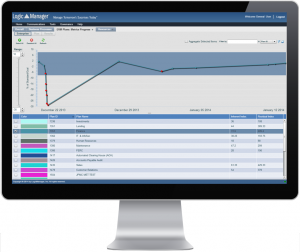Performance Management Software

LogicManager enables organizations to identify risks, assess them based upon likelihood, impact and assurance, evaluate whether action is needed, and devise mitigation or business building activities if needed. Managers can then specify and record measurements to track effectiveness, and finally formalize the connection between risks, operational activities, and balanced scorecard objectives.
Our enterprise GRC tools help connect risks to mitigation activities, metrics, and business initiative data, which allows organizations to detect increased threat levels and identify emerging risks before your business metrics become out of tolerance.
Here are some examples of what LogicManager’s Enterprise Risk Management software solution can do for you:
- Manage Relationships – With LogicManager, performance management is more than just tracking business metrics. It’s about knowing what to measure, being alerted when that measure is out of tolerance, and knowing who needs to be involved across the organization to take corrective action when incidents occur. LogicManager enables you to leverage risk vs reward trade-offs in all activities and decision making to reach your goals. LogicManager’s ERM software includes robust balanced scorecard capabilities that align business activities to the strategy of the organization through risk management.
- Gain Efficiency – Real-time tracking of metrics on an ongoing basis allows businesses to allocate resources to critical areas, as well as focus on forward-looking measures to identify and manage emerging risks. Preventative, proactive measures are often indistinguishable from reactive measures, as metrics do not formally tie back to any commitments or risks. As a result, resources may be focused on activities related to historical and non-critical risks. Once connections are made between risks, mitigation activities, and performance goals, organizations can eliminate activities and measures that have low priority or have no connection to risks or business initiatives, driving efficiency through the business.
- Set Priorities – Most organizations have no way of knowing how changing and emerging threats will affect their risk metrics. LogicManager’s risk management software allows organizations to see forward looking trends, and prioritize business metrics based on changing threat levels. Assessing risks and linking them to business activities allows organizations to prioritize which activities need to be monitored closely. Through regular quarterly or annual risk assessments, organizations can detect increased threat levels and identify new emerging risks before they materialize and bring your business metrics out of tolerance.
Performance Management Software Features
1. Balanced Scorecard
- Key Performance Indicator (KPI) Library – Leverage a comprehensive pre-built register of key performance indicators to identify business goals and evaluate action plans.
- Evaluation Criteria – Use pre-loaded standardized evaluation criteria to quantify opportunities and prioritize resources.
- Validation – Automate completeness tests to ensure that goals are managed by policies, procedures, controls and measured.
2. Business Metrics (Risk Indicators – KRI, Flash Reports)
- Measures – Collect and aggregate related business metrics from across multiple business areas.
- Prioritization – Prioritize business metrics based on the importance of the risks and goals they relate to.
- Gap Analysis – Understand gaps where key risks and goals are not monitored by business metrics.
- Trend Analysis – Analyze trends over time within and across business areas.
3. Operational Activities
- Measures – Align business process goals and objectives with actionable and measurable activities.
- Linkage – Prioritize business metrics based on the importance of the goals activities they relate to.
- Monitor Goal Achievement – Track business metrics over time to ensure that your risk levels are within tolerance.
4. Operational Reviews
- Resource Allocation – Use standardized criteria to compare risk assessments on initiatives like cost–cutting, customer satisfaction, and new product introductions on an apples–to–apples basis across to better allocate resources.
- Variances – Identify where key activities across business silos and levels are moving outside of high/low limits or thresholds.
- Wasted Resources – The resources available to accomplish strategic imperatives and to mitigate risk is finite. Staff will often continue to manage obsolete or unimportant measures rather than aligning with current goals and objectives.
- Budgeting – Generate status reports that link resource allocations to goal achievement for budget committees and operational reviews.
5. Customer Response Management
- Customer Complaints– Captures, escalate and report on customer complaints through configurable fields to ensure collection of necessary data.
- Status– Organize and understand the nature and source of complaints.
- Response – Engage necessary business resources to analyze and develop responses.
- Investigations – Track a threaded discussion to investigate issues and assign responsibilities to bring issues to resolution.
- Issues – Manage corrective actions for internal and external audit findings.
6. Business Intelligence Tools
- Pre–configured Dashboards & Reports – Benefit from dashboards and reports to track activities at the department and enterprise levels.
- Status – Track the current status of operational activities and monitor upcoming changes.
Watch our video on how to use a common ERM software-as-a-service platform to more effectively achieve corporate strategic objectives.
